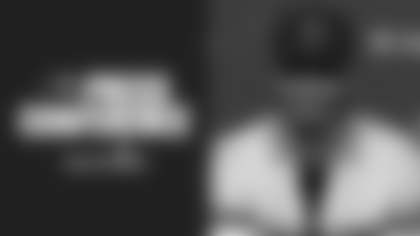The most famous trade involving the NFL draft – or infamous depending upon which team you favor – actually occurred during the middle of the 1989 season, when the Dallas Cowboys traded running back Herschel Walker to the Minnesota Vikings for five players and eight draft picks. That deal laid the foundation for a dynasty in Dallas while failing to deliver a championship to the Vikings.
The second most famous NFL draft trade ended up with Mike Ditka and Ricky Williams in wedding regalia on the cover of a popular magazine.
That latter deal, a remarkably aggressive and probably ill-advised trade engineered by Ditka and the New Orleans Saints in 1999 is the one we'll be examining in this installment of our week-long Five for Five series. There have been 11 NFL drafts in which the fifth-overall pick was traded in one way or another, and five of those 11 involved the team in the fifth spot trading down to a later pick in the first round. The Tampa Bay Buccaneers head into the 2019 draft in possession of that fifth-overall pick and could be motivated to trade down if the right set of circumstances arises.
At the very least, General Manager Jason Licht will take the call if another club is interested in trading for the fifth pick. As Licht said at the NFL Scouting Combine in February: "If anyone wants it, we'd certainly listen."
The purpose of looking back at trade-down scenarios from the fifth pick is to see what the stakes were and how well it worked out for both teams involved, and we're looking at one of those five previous trades each day this week. On Monday, we recalled the most recent such deal, which happened to be executed by the Buccaneers themselves in 2012. That was a very small slide down, from #5 to #7. (That installment also runs down the sixth other drafts in which the fifth pick was traded in different sorts of deals.) On Tuesday, we rewound to the Browns-Jets deal of 2009, which was a much bigger trade because Cleveland moved all the way down to #17.
Now we take a look at Ditka's unforgettable gambit, which in a way had echoes of that aforementioned Vikings deal. Minnesota thought they were one piece away from being a championship team, and thus mortgaged an incredible bundle of assets, including three first-round picks and three second-round picks, for Walker. Despite coming off a 6-10 record in 1998, the Saints must have had similar thoughts, or at least felt like Williams was the key to a turnaround, because they gave up an entire draft and more to get one player.
In this scenario, the Buccaneers would not be the Saints but the team they traded with, the Washington Redskins, who originally owned the fifth pick in that draft. Safe to say, the Bucs – or any team for that matter – would jump at a similar offer. Let's check it out.
**
Trade #3: Mike Ditka and the Saints Give it All Up for Ricky Williams
The Trade: Washington sends the fifth overall pick to New Orleans for the 12th overall pick plus the Saints' third, fourth, fifth, sixth and seventh-round picks in 1999. Oh, and the Saints threw in their first and third-round picks in the 2000 draft for good measure. That first-round pick in 2000 ended up being the second-overall selection, which should be your first clue that this deal did not go well for Ditka and the Saints. At all.
Trade Value: There are two "trade value charts" in common use, both of which assign specific numeric values to each spot in the draft through, declining in value from pick #1 to #224. The first is commonly known as the Jimmy Johnson Chart because it was developed by Johnson and the Dallas Cowboys in the early 1990s. It assigns a value of 3,000 points to the first-overall pick, 2,600 to the second and so on, with the values dropping steeply. The last pick in the first round, for instance, is valued at 590 points.
The second chart was developed by Chase Stuart of Football Perspective in 2012. While Johnson and his crew devised their original chart with a relatively arbitrary system, Stuart attempted to come up with values using empirical evidence of what those draft spots had provided in the past. Stuart's chart begins with a value of 34.6 points for the first overall pick and, obviously, doesn't decline as rapidly. For each of these trades, we'll look at how close the two teams got to swapping equal value, as determined by the two charts.
This was, as you would expect, a wild overpay by the Saints on both charts, but particularly on the Stuart chart, which values the picks Washington received as being worth more than three times the value of the pick it gave up.
It's probably a good thing for the Saints that they had already traded their 1999 second-round pick to the Rams for wide receiver Eddie Kennison in February of that year, because that selection probably would have been lumped into this deal, too. At the league meetings in March, Ditka had stated publicly that he wanted Texas running back Ricky Williams, the Heisman Trophy winner, and was willing to give up the Saints' whole draft to make it happen.
The actual numbers on the trade value charts are a little tricky with this one because the two picks in the 2000 draft figure in prominently to the overall value. Teams tend to value picks in the following year's draft at being a round below what they really are. In addition, neither the Saints nor the Redskins knew exactly where those picks would fall in the first and third rounds of the 2000 draft. That they ended up being so high eventually made them much more valuable.
If the Saints had just traded away their entire 1999 draft to trade up seven spots on the first round, they actually would have been somewhat justified in doing so on the Johnson chart. That chart values the fifth-overall pick at 1,700 points and the 12th-overall pick at 1, 200 points, meaning the Redskins would have to get back at least 500 points of value on all the other picks to break even. They did not. The 71st, 107th, 144th, 179th and 218th picks added up to 373 points, putting the total value going to Washington at 1,573.
However, if we add in the value of what those 2000 picks ended up being – second and 64th – we get all the way up to 4,443 points for Washington, which is a tidy little return on the 1,700 points spent. Even if we apply the conventional wisdom that the next year's picks are worth one round lower it still comes out to 2,273 points for Washington.
The Stuart chart likes the deal even without the 2000 picks, giving the Redskins' package a value of 36.0 points in just 1999 commodities. Add in the eventual value of the 2000 picks and you get a whopping 74.3 in exchange for the 24.3 points that the fifth-overall pick in 1999 cost them. Take those 2000 picks down a round and it's still 53.8 points for Washington.
Trade Results in the Draft: The Saints used the fifth pick in just the manner they had claimed they would, taking Williams fifth overall. Interestingly, Williams wasn't even the first running back selected, as the Indianapolis Colts nabbed Edgerrin James with the fourth pick. The Saints also got an ESPN The Magazine cover out of in August, with Williams in a wedding dress, Ditka in a tux and a title of "For Better or Worse, Ricky & Ditka Take the Plunge."
Washington mostly used their gained 1999 draft capital to move around the board the rest of the weekend. It started out well enough, as they included the Saints' third-round pick (#71) in a package of four selections to move back up from #12 to #7 and nab cornerback Champ Bailey. Bailey is headed to the Hall of Fame this summer, though he spent two-thirds of his 15-year career in Denver after he was traded to the Broncos for running back Clinton Portis in 2004.
The team did stay put with pick #107 in the fourth round, selecting linebacker Nate Stimson. However, Stimson failed to make the team as a rookie and never played in the NFL.
Later, Washington dealt the fifth-rounder it got from New Orleans in order to move up three spots in the second round before selecting tackle Jon Jansen. Jansen never made the Pro Bowl or earned first-team All-Pro honors but he was a very good right tackle for a decade in Washington, and that's good value for the 37th pick. Later, the Redskins used the 179th and 218th picks they received from New Orleans to buy the 165th pick from Denver. That was used on Virginia Tech tackle Derek Smith (not to be confused with linebacker Derek Smith, whom the Redskins had drafted two years earlier), but Smith never played a regular-season game in the NFL.
The next year, Washington stayed put at the two 2000 draft spots they had gained in the trade with New Orleans and selected linebacker LaVar Arrington at #2 and cornerback Lloyd Harrison at #64. Arrington made the Pro Bowl in three of his first four seasons and then signed a new eight-year contract with the Redskins. However, knee and Achilles tendon injuries followed and his career would end after six seasons in Washington and one with the New York Giants. Harrison played just two games for the Redskins and a total of 16 overall for Washington, San Diego and Miami from 2000-02.
How it Worked Out: We spoiled this one early, but this was not a good trade for the Saints, nor was it widely considered a wise move at the time. Though the running back position had yet to see its overall draft popularity crater, as it would about a decade later, it was still an incredible amount of assets to pour into one player, particularly one that didn't play quarterback.
Moreover, the Colts got arguably a better running back one spot before the Saints and didn't have to give up seven additional picks to do it. James would rush for 12,246 yards, get 15,610 yards from scrimmage and score 91 touchdowns in his career, which he opened by earning Pro Bowl and first-team All-Pro honors as a rookie. Williams had 884 rushing yards and two touchdowns as a rookie.
Williams would go on to make one Pro Bowl and earn first-team All-Pro honors once, both in 2002, his first year in Miami after the Saints traded him to the Dolphins. Undeniably talented, Williams ran for 1,853 yards and 16 touchdowns that season and had 2,216 yards from scrimmage. He would later miss the 2004 season after briefly retiring and the 2006 campaign on an NFL suspension. He would return from both to eventually rush for 10,009 yards, gain 12,615 yards from scrimmage and score 74 times.
Only about 30% of those totals came in New Orleans, unfortunately, and the Saints used another first-round pick on a running back, Deuce McAllister, just two years after they picked Williams.
In the shortest-term evaluation of the trade, the Saints went 3-13 in 1999 and Ditka was fired after three years at the helm. Clearly, the honeymoon period was short.
Washington didn't quite light the world on fire with its bounty of picks. Bailey, Arrington and Jansen were all good players – Bailey was a great player – but Bailey was traded after five seasons and Arrington's promising career was cut short. The other three players the Redskins took either with selections they got from the Saints or picks they acquired via those selections failed to make any impact at all. Harrison, a high third-round pick, was a notable miss.
Lessons for the 2019 Buccaneers: This isn't particularly complicated. If a team wants to give you its entire draft, and then some, to move down five spots, you should probably do it. It's worth noting, however, that the Saints tried to pitch similar deals to all the teams holding top-five picks but only got Washington to bite. The Cincinnati Bengals, at #3, reportedly turned down a nine-pick offer for that spot (and then, sadly, selected Akili Smith). The first three picks that year were all quarterbacks, which is likely why none of those teams wanted to trade down, even for a bevy of picks. The Buccaneers are not expected to draft a quarterback this year so would almost certainly be willing to listen.
That kind of deal likely isn't coming, and it definitely won't be offered by a team looking to draft a running back. However, it's not out of the question that a team will be motivated to inquire about a deal moving up from roughly the same spot – 12th overall – to the Bucs' fifth pick. That team would almost surely be seeking a quarterback, and the Bucs might be in a very good spot if Oklahoma's Kyler Murray is drafted first overall. That could make QB-needy teams more aggressive in pursuit of Ohio State's Dwayne Haskins or Missouri's Drew Lock.
The Green Bay Packers own the 12th pick and one can assume they're not yet looking for a replacement for Aaron Rodgers. However, the Miami Dolphins are next at #13 and, despite signing veteran Ryan Fitzpatrick last week, still could seek a long-term solution. Even the Cincinnati Bengals, in the 11th hole, could conceivably be looking for the successor to Andy Dalton.
If so, the Bucs could reasonably expect to get at least a high second-round pick out of the deal. Miami's second-rounder, #48 overall, might not be enough to get it done, so the deal could involve an additional pick later in this draft or perhaps some asset in next year's draft.



































